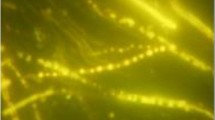Abstract
The extracellular lipase production of a sapwood-staining fungus, Ophiostoma piceae, grown in liquid media, was optimally active at pH 5.5 and 37°C. Although glucose, fructose, sucrose, starch and dextrin, as carbon sources for growth gave similar mycelial yields, which were higher than those obtained with arabinose, galactose or raffinose, the cells growing on those carbohydrates produced little extracellular lipase. However, both high biomass and lipase activity were obtained when plant oils (olive, soybean, corn, sunflower seed, sesame, cotton seed or peanut) were used as carbon sources. Among the nitrogen sources examined, Casamino acids gave the best growth, whereas (NH4)2SO4 gave the best lipase production. The highest lipase productivity seen was obtained in a medium with olive oil as carbon source and a combination of (NH4)2SO4and peptone as nitrogen source.
Similar content being viewed by others
References
AbrahamL.D., RothA., SaddlerJ.N. & BreuilC. 1993 Growth, nutrition, and proteolytic activity of the sap-staining fungus Ophiostoma piceae. Canadian Journal of Botany 71, 1224–1230.
AllenL.H. 1988 Pitch control during the production of aspen kraft pulp. Pulp and Paper Canada 89, 87–91.
BaillargeonM.W. & McCarthyS.G. 1991 Geotrichum candidum NRRL Y-553 lipase: purification, characterization and fatty acid specificity. Lipids 26, 831–836.
BallardR.G., WalshM.A. & ColeW.E. 1982 Blue-stain fungi in xylem of lodgepole pine: a light-microscope study on extent of hyphal distribution. Canadian Journal of Botany 60, 2334–2341.
BlanchetteR.A., FarrellR.L., BurnesT.A., WendlerP.A., ZimmermanW., BrushT.S. & SnyderR.A. 1992 Biological control of pitch in pulp and paper production by Ophiostoma piliferum. Tappi Journal 75, 102–106.
BrushT.S., FarrellR.L. & HoC. 1994 Biodegradation of wood extractives from southern yellow pine by Ophiostoma piliferum. Tappi Journal 77, 155–159.
ChristakopoulosP., TziaC., KelosD. & MacrisB.J. 1992 Production and characterization of extracellular lipase from Calvatia gigantea. Applied Microbiology and Biotechnology 38, 194–197.
Clubbe, C.P. 1980 The Colonisation and Succession of Fungi in Wood. Document IRG/WP/1107. International Research Group on Wood Preservation.
EllisK.J. & MorrisonJ.F. 1982 Buffers of constant ionic strength for studying pH-dependent processes. Methods in Enzymology 87, 405–426.
FischerK. & MessnerK. 1992 Reducing troublesome pitch in pulp mills by lipolytic enzymes. Tappi Journal 75, 130–134.
GaoY., BreuilC. & ChenT. 1994 Utilization of triglycerides, fatty acids, and resin acids in lodgepole pine wood by a sapstaining fungus Ophiostoma piceae. Material und Organismen 28, 105–118.
GaoY., ChenT. & BreuilC. 1993 Ergosterol—a measure of fungal growth in wood for staining and pitch control fungi. Biotechnology Techniques 7, 621–626.
GaoY., ChenT. & BreuilC. 1995 Identification and quantification of nonvolatile lipophilic substances in fresh sapwood and heartwood of lodgepole pine (Pinus contorta Dougl.). Holzforschung 49, 20–28.
GibbsJ.N. 1993 The biology of Ophiostomatoid fungi causing sapstain in trees and freshly cut logs. In Ceratocystis and Ophiostoma Taxonomy, Ecology, and Pathogenicity, eds WingfieldM.J., SeifertK.A. & WebberJ.F. pp. 153–160. St Paul: American Phytopathological Society.
IwaiM. & TsujisakaY. 1974 The purification and properties of the three kinds of lipases from Rhizopus delemar. Agricultural and Biological Chemistry 38, 1241–1247.
LazarG. & SchröderF.R. 1992 Degradation of lipids by fungi. In Microbial Degradation of Natural Products, ed WinkelmannG. pp. 267–291 Weinheim: VCH.
LippiU.G., StevanatoG. & GuidiG. 1972 A rapid photometric micromethod for serum lipase determination. Clinica Chimica Acta 37, 199–202.
MontenecourtB.S. & EveleighD.E. 1977 Semiquantitative plate assay for determination of cellulase production by Trichoderma viride. Applied and Environmental Microbiology 33, 178–183.
OhnishiK., YoshidaY. & SekiguchiJ. 1994 Lipase production of Aspergillus oryzae. Journal of Fermentation and Bioengineering 77, 490–495.
PalN., DasS. & KunduA.K. 1978 Influence of culture and nutritional conditions on the production of lipase by submerged culture of Aspergillus niger. Journal of Fermentation Technology 56, 593–598.
PapaparaskevasD., ChristakopoulosP., KekosD. & MacrisB.J. 1992 Optimizing production of extracellular lipase from Rhodotorula glutinis. Biotechnology Letters 14, 397–402.
RaynerA.D.M. & BoddyL. 1988 Fungal Decomposition of Wood: Its Biology and Ecology. Chichester, UK: John Wiley & Sons.
SamadM.Y.A., SallehA.B., RazakC.N.A., AmponK., YunusW.M.Z.W. & BarsiM. 1990 A lipase from a newly isolated thermophilic Rhizopus rhizopodiformis. World Journal of Microbiology and Biotechnology 6, 390–394.
SavithaJ. & RatledgeC. 1992 An inducible, intracellular, alkalophilic lipase in Aspergillus flavipes grown on triacylglycerols. World Journal of Microbiology and Biotechnology 8, 129–131.
SeifertK.A. 1993 Sapstain of commercial lumber by species of Ophiostoma and Ceratocystis. In Ceratocystis and Ophiostoma Taxonomy, Ecology, and Pathogenicity, eds WingfieldM.J., SeifertK.A. & WebberJ.F. pp. 141–151. St Paul: American Phytopathological Society.
SeitzE.W. 1974 Industrial application of microbial lipases: a review. Journal of the American Oil Chemists' Society 51, 12–16.
VogelH.J. 1956 A convenient growth medium for Neurospora (Medium N). Microbial Genetics Bulletin 13, 42–43.
WheelerM.H. 1983 Comparisons of fungal melanin synthesis in ascomycetous, imperfect and basidiomycetous fungi. Transactions of the British Mycological Society 81, 29–36.
ZinkP. & FengelD. 1988 Studies on the colouring matter of blue-stain fungi. Part 1. General characterization and the associated compounds. Holzforschung 42, 217–220.
Additional information
The authors are with Forest Products Biotechnology, Department of Wood Science, Facully of Forestry, University of British Columbia, Vancouver, BC, V6T 1Z4, Canada
Rights and permissions
About this article
Cite this article
Gao, Y., Breuil, C. Extracellular lipase production by a sapwood-staining fungus, Ophiostoma piceae . World Journal of Microbiology & Biotechnology 11, 638–642 (1995). https://doi.org/10.1007/BF00361006
Received:
Accepted:
Issue Date:
DOI: https://doi.org/10.1007/BF00361006




